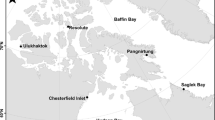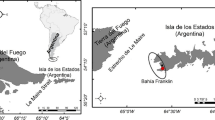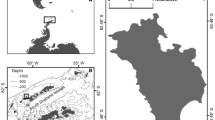Abstract
Interspecific interactions may be altered as a result of poleward species range shifts caused by climate change. In recent decades, Cumberland Sound, Nunavut, in the Canadian Arctic, has undergone concurrent increases in the availability of the forage fish capelin (Mallotus villosus) and the number of migratory harp seals (Pagophilus groenlandicus) during the open-water period; however, the impacts of these changes on endemic Arctic species, such as ringed seals (Pusa hispida), have received little attention. We coupled stomach contents with stable isotope analysis (δ13C and δ15N) of muscle and liver to determine the extent of potential competition between ringed seals (n = 91) and harp seals (n = 39) in Cumberland Sound. Isotopic niche breadth was greater for ringed seals (95% ellipse: 10.08‰2) than for harp seals (95% ellipse: 8.00‰2), and harp seal isotopic niche overlapped more with ringed seal isotopic niche than vice versa, suggesting asymmetrical competition potential. Although there was high overlap in isotopic niche breadth (range 50.3–91.0%) and prey species consumed (Schoener’s Index 0.60), stomach content analysis revealed differences in prey species proportions and size composition, thereby reducing the degree of realized niche overlap. Harp seals consumed a higher biomass of fish (66.7%) than did ringed seals (31.9%), and harp seals also consumed larger capelin (64–200 mm), polar cod (Boreogadus saida; 28–194 mm), and Liparidae (55–115 mm) than ringed seals (63–154 mm, 20–189 mm, and 16–128 mm, respectively). With climate change and range shifts predicted to continue into the future, our results provide an important baseline for future studies examining interspecific interactions.





Similar content being viewed by others
References
Alley TR (1982) Competition theory, evolution, and the concept of an ecological niche. Acta Biotheor 31:165–179. https://doi.org/10.1007/BF01857239
Beck GG, Hammill MO, Smith TG (1993) Seasonal variation in the diet of harp seals (Phoca groenlandica) from the Gulf of St. Lawrence and Western Hudson Strait. Can J Fish Aquat Sci 50:1363–1371
Ben-David M, Flaherty EA (2012) Stable isotopes in mammalian research: a beginner’s guide. J Mammal 93:312–328. https://doi.org/10.1644/11-MAMM-S-166.1
Boecklen WJ, Yarnes CT, Cook BA, James AC (2011) On the use of stable isotopes in trophic ecology. Annu Rev Ecol Evol Syst 42:411–440. https://doi.org/10.1146/annurev-ecolsys-102209-144726
Born EW, Teilmann J, Acquarone M, Riget FF (2004) Habitat Use of Ringed Seals (Phoca hispida) in the North Water Area (North Baffin Bay). Arctic 57:129–142. https://doi.org/10.14430/arctic490
Carscadden JE, Montevecchi WA, Davoren GK, Nakashima BS (2002) Trophic relationships among capelin (Mallotus villosus) and seabirds in a changing ecosystem. ICES J Mar Sci 59:1027–1033. https://doi.org/10.1006/jmsc.2002.1235
Carscadden JE, Gjøsæter H, Vilhjálmsson H (2013) A comparison of recent changes in distribution of capelin (Mallotus villosus) in the Barents Sea, around Iceland and in the Northwest Atlantic. Prog Oceanogr 114:64–83. https://doi.org/10.1016/j.pocean.2013.05.005
Chambellant M, Stirling I, Ferguson SH (2013) Temporal variation in western Hudson Bay ringed seal Phoca hispida diet in relation to environment. Mar Ecol Prog Ser 481:269–287. https://doi.org/10.3354/meps10134
Crawford JA, Quakenbush LT, Citta JJ (2015) A comparison of ringed and bearded seal diet, condition and productivity between historical (1975–1984) and recent (2003–2012) periods in the Alaskan Bering and Chukchi seas. Prog Oceanogr 136:133–150. https://doi.org/10.1016/j.pocean.2015.05.011
DFO (2011) Current status of northwest Atlantic harp seals (Pagophilus groenlandicus). DFO Can. Sci. Advis. Sec. Sci. Advis. Rep. 2011/050
Diemer KM, Conroy MJ, Ferguson SH et al (2011) Marine mammal and seabird summer distribution and abundance in the fjords of northeast Cumberland Sound of Baffin Island, Nunavut, Canada. Polar Biol 34:41–48. https://doi.org/10.1007/s00300-010-0857-1
Elliott KH, Gaston AJ (2008) Mass-length relationships and energy content of fishes and invertebrates delivered to nestling Thick-billed Murres Uria lomvia in the Canadian Arctic, 1981–2007. Mar Ornithol 36:25–34
Folkow LP, Nordøy ES, Blix AS (2004) Distribution and diving behaviour of harp seals (Pagophilus groenlandicus) from the Greenland Sea stock. Polar Biol 27:281–298. https://doi.org/10.1007/s00300-004-0591-7
Gottfried MD (2014) Short note: cooperative foraging behaviour by crabeater seals (Lobodon carcinophaga) at Pleneau Island, Antarctic Peninsula. Antarct Sci 26:263–264. https://doi.org/10.1017/S0954102013000941
Graham BS, Koch PL, Newsome SD, McMahon KW, Aurioles D (2010) Using isoscapes to trace the movements and foraging behavior of top predators in oceanic ecosystems. In: West JB, Bowen GJ, Dawson TE, Tu KP (eds) Isoscapes: Understanding movement, pattern, and process on Earth through isotope mapping, 1st edn. Springer, Dordrecht, pp 299–318
Gruber N, Keeling D, Bacastow RB, Guenther PR, Lueker TJ, Wahlen M, Meijer HJ, Mook WG, Stocker TF (1999) Spatiotemporal patterns of carbon-13 in the global surface oceans and the oceanic Suess effect. Global Biogeochem Cycles 13:307–335. https://doi.org/10.1029/1999gb900019
Hammill MO (2009) Ringed seals. In: Perrin WF, Würsig B, Thewissen JGM (eds) Encyclopedia of marine mammals, 2nd edn. Academic Press, San Diego, pp 972–974
Hammill MO, Stenson GB, Doniol-Valcroze T, Mosnier A (2015) Conservation of northwest Atlantic harp seals: past success, future uncertainty? Biol Conserv 192:181–191. https://doi.org/10.1016/j.biocon.2015.09.016
Hardin G (1960) The competitive exclusion principle. Am Assoc Adv Sci 131:1292–1297
Härkönen T (1986) Guide to the otoliths of the bony fishes of the Northeast Atlantic. Danbui ApS, Hellerup
Heithaus MR, Dill LM (2009) Feeding strategies and tactics. In: Perrin WF, Würsig B, Thewissen JGM (eds) Encyclopedia of marine mammals, 2nd edn. Academic Press, San Diego, pp 414–423
Helm RC (1984) Rate of digestion in three species of pinnipeds. Can J Zool 62:1751–1756. https://doi.org/10.1139/z84-258
Hickling R, Roy DB, Hill JK et al (2006) The distributions of a wide range of taxonomic groups are expanding polewards. Glob Chang Biol 12:450–455. https://doi.org/10.1111/j.1365-2486.2006.01116.x
Hobson KA, Fisk A, Karnovsky N et al (2002) A stable isotope (δ 13C, δ 15N) model for the North Water food web: implications for evaluating trophodynamics and the flow of energy and contaminants. Deep Res Part II Top Stud Oceanogr 49:5131–5150. https://doi.org/10.1016/S0967-0645(02)00182-0
Holst M, Stirling I, Hobson KA (2001) Diet of ringed seals (Phoca hispida) on the east and west sides of the North Water Polynya, northern Baffin Bay. Mar Mammal Sci 17:888–908. https://doi.org/10.1111/j.1748-7692.2001.tb01304.x
Hop H, Gjøsæter H (2013) Polar cod (Boreogadus saida) and capelin (Mallotus villosus) as key species in marine food webs of the Arctic and the Barents Sea. Mar Biol Res 9:878–894. https://doi.org/10.1080/17451000.2013.775458
Horstmann-Dehn L, Follmann EH, Rosa C, Zelensky G, George C (2012) Stable carbon and nitrogen isotope ratios in muscle and epidermis of arctic whales. Mar Mammal Sci 28(2):E173–E190. https://doi.org/10.1111/j.1748-7692.2011.00503.x
Hoskins AJ, Schumann N, Costa DP, Arnould JPY (2017) Foraging niche separation in sympatric temperate-latitude fur seal species. Mar Ecol Prog Ser 566:229–241. https://doi.org/10.3354/meps12024
Hutchinson GE (1957) Concluding remarks. Cold Spring Harb Symp Quant Biol 22:415–427
Ingram T, Matthews B, Harrod C, Stephens T, Grey J, Markel R (2007) Lipid extraction has little effect on the δ15 N of aquatic consumers. Limnol Oceanogr Methods 5:338–343. https://doi.org/10.4319/lom.2007.5.338
IPCC (2014) Climate Change 2014: synthesis report. contribution of working groups I, II and III to the Fifth Assessment Report of the Intergovernmental Panel on Climate Change. [Core Writing Team, R.K. Pachauri and L.A. Meyer (eds.)]. IPCC, Geneva, Switzerland. https://doi.org/10.1017/cbo9781107415324.004
Jackson AL, Inger R, Parnell AC, Bearhop S (2011) Comparing isotopic niche widths among and within communities: SIBER—Stable Isotope Bayesian Ellipses in R. J Anim Ecol 80:595–602. https://doi.org/10.1111/j.1365-2656.2011.01806.x
Kelly BP, Wartzok D (1996) Ringed seal diving behavior in the breeding season. Can J Zool 74:1547–1555. https://doi.org/10.1139/z96-169
Koszteyn J, Kwaśniewski S, Rόżycki O, Węslawski J (1990) Atlas of the marine fauna of Southern Spitsbergen—Invertebrates Part 1, vol 2. Polish Academy of Sciences, Gdańsk
Kovacs KM, Lydersen C (2008) Climate change impacts on seals and whales in the North Atlantic Arctic and adjacent shelf seas. Sci Prog 91:117–150. https://doi.org/10.3184/003685008X324010
Kovacs KM, Lydersen C, Overland JE, Moore SE (2011) Impacts of changing sea-ice conditions on Arctic marine mammals. Mar Biodivers 41:181–194. https://doi.org/10.1007/s12526-010-0061-0
Krafft BA, Kovacs KM, Frie AK et al (2006) Growth and population parameters of ringed seals (Pusa hispida) from Svalbard, Norway, 2002–2004. ICES J Mar Sci 63:1136–1144. https://doi.org/10.1016/j.icesjms.2006.04.001
Lavigne DM (2009) Harp Seal: Pagophilus groenlandicus. In: Perrin WF, Würsig B, Thewissen JGM (eds) Encyclopedia of marine mammals, 2nd edn. Academic Press, San Diego, pp 542–546
Law R, Marrow P, Dieckmann U (1997) On evolution under asymmetric competition. Evol Ecol 11:485–501. https://doi.org/10.1023/A:1018441108982
Lawson JW, Miller EH, Noseworthy E (1997) Variation in assimilation efficiency and digestive efficiency of captive harp seals (Phoca groenlandica) on different diets. Can J Zool 75:1285–1291. https://doi.org/10.1139/z97-152
Lydersen C, Ryg MS, Hammill MO, O’Brien PJ (1992) Oxygen stores and aerobic dive limit of ringed seals (Phoca hispida). Can J Zool 70:458–461. https://doi.org/10.1139/z92-069
Macpherson E, Duarte CM (1991) Bathymetric trends in demersal fish size: is there a general relationship? Mar Ecol Prog Ser 71:103–112. https://doi.org/10.3354/meps071103
Marcoux M, McMeans BC, Fisk AT, Ferguson SH (2012) Composition and temporal variation in the diet of beluga whales, derived from stable isotopes. Mar Ecol Prog Ser 471:283–291. https://doi.org/10.3354/meps10029
McLaren IA (1958) The biology of the ringed seal (Phoca hispida Schreher) in the Eastern Canadian Arctic. Fish Res Board Canada 118:1–97
McNicholl DG, Davoren GK, Reist JD (2018) Life history variation across latitudes: observations between capelin (Mallotus villosus) from Newfoundland and the eastern Canadian Arctic. Polar Biol 41:643–651. https://doi.org/10.1007/s00300-017-2225-x
Michener RH, Kaufman L (2007) Stable isotope ratios as tracers in marine food webs: An update. In: Michener RH, Kaufman L (eds) Stable isotopes in ecology and environmental science, 2nd edn. Blackwell Publishing Ltd, Bosten, pp 238–282
Moore SE, Huntington HP (2008) Arctic marine mammals and climate change: impacts and resilience. Ecol Appl 18:s157–s165. https://doi.org/10.1890/06-0571.1
Ogloff W (2018) Climate change-related shifts in species interactions and diet in an Arctic marine ecosystem. Master’s Thesis. Biological Sciences, University of Manitoba, Winnipeg, Manitoba
Orlova EL, Dolgov AV, Rudneva GB et al (2009) Trophic relations of capelin Mallotus villosus and polar cod Boreogadus saida in the Barents Sea as a factor of impact on the ecosystem. Deep Res Part II Top Stud Oceanogr 56:2054–2067. https://doi.org/10.1016/j.dsr2.2008.11.016
Osuga DT, Feeney RE (1978) Antifreeze glycoproteins from Arctic fish. J Biol Chem 253:5338–5343
Parmesan C, Yohe G (2003) A globally coherent fingerprint of climate change impacts across natural systems. Nature 421:37–42. https://doi.org/10.1038/nature01286
Persson L (1985) Asymmetrical competition: are larger animals competitively superior? Am Nat 126:261–266
Pierce GJ, Boyle PR (1991) A review of methods for diet analysis in piscivorous marine mammals. Oceanogr Mar Biol Annu Rev 29:409–486
Quakenbush L, Citta J, Crawford J (2011) Biology of the ringed seal (Phoca hispida) in Alaska, 1960–2010. Final Report to: National Marine Fisheries Service
Ronald K, Dougan JL (1982) The ice lover: biology of the harp seal (Phoca groenlandica). Science 215:928–933. https://doi.org/10.1126/science.215.4535.928
Root TL, Price JT, Hall KR et al (2003) Fingerprints of global warming on wild animals and plants. Nature 421:57–60. https://doi.org/10.1038/nature01333
Sars GO (1895) Amphipoda. In: An account of the Crustacea of Norway with short descriptions and figures of all the species. vol 1. Alb. Cammermeyers Forlag, Christiania and Copenhagen, p 711
Schoener TW (1970) Nonsynchronous spatial overlap of lizards in patchy habitats. Ecology 51:408–418
Schoener TW (1983) Field experiments on interspecific competition. Am Nat 122:240–285
Siegstad H, Neve PB, Heide-Jørgensen MP, Härkönen T (1998) Diet of the ringed seal (Phoca hispida) in Greenland. NAMMCO Sci Pub 1:229–241. https://doi.org/10.7557/3.2991
Syväranta J, Lensu A, Marjomäki TJ et al (2013) An empirical evaluation of the utility of convex hull and standard ellipse areas for assessing population niche widths from stable isotope data. PLoS One 8:1–8. https://doi.org/10.1371/journal.pone.0056094
Tieszen LL, Boutton TW, Tesdahl KG, Slade NA (1983) Fractionation and turnover of stable carbon isotopes in animal tissues: implications for δ 13C analysis of diet. Oecologia 57:32–37. https://doi.org/10.1007/bf00379558
Tucker S, Bowen WD, Iverson SJ, Stenson GB (2009) Intrinsic and extrinsic sources of variation in the diets of harp and hooded seals revealed by fatty acid profiles. Can J Zool 87:139–151. https://doi.org/10.1139/Z08-145
Vander Zanden MJ, Clayton MK, Moody EK et al (2015) Stable isotope turnover and half-life in animal tissues: a literature synthesis. PLoS One 10:16. https://doi.org/10.1371/journal.pone.0116182
Walkusz W, Majewski A, Reist JD (2013) Distribution and diet of the bottom dwelling Arctic cod in the Canadian Beaufort Sea. J Mar Syst 127:65–75. https://doi.org/10.1016/j.jmarsys.2012.04.004
Wallace RKJ (1981) An assessment of diet-overlap indexes. Trans Am Fish Soc 110:72–76. https://doi.org/10.1577/1548-8659(1981)110%3c72:AAODI%3e2.0.CO;2
Wathne JA, Haug T, Lydersen C (2000) Prey preference and niche overlap of ringed seals Phoca hispida and harp seals P. groenlandica in the Barents Sea. Mar Ecol Prog Ser 194:233–239. https://doi.org/10.3354/meps194233
Young BG, Loseto LL, Ferguson SH (2010) Diet differences among age classes of Arctic seals: evidence from stable isotope and mercury biomarkers. Polar Biol 33:153–162. https://doi.org/10.1007/s00300-009-0693-3
Yurkowski DJ, Hussey NE, Semeniuk C, Ferguson SH, Fisk AT (2015) Effects of lipid extraction and the utility of lipid normalization models on δ13C and δ15 N values in Arctic marine mammal tissues. Polar Biol 38:131–143. https://doi.org/10.1007/s00300-014-1571-1
Yurkowski DJ, Ferguson SH, Choy ES et al (2016a) Latitudinal variation in ecological opportunity and intraspecific competition indicates differences in niche variability and diet specialization of Arctic marine predators. Ecol Evol 6:1666–1678. https://doi.org/10.1002/ece3.1980
Yurkowski DJ, Ferguson SH, Semeniuk CAD et al (2016b) Spatial and temporal variation of an ice-adapted predator’s feeding ecology in a changing Arctic marine ecosystem. Oecologia 180:631–644. https://doi.org/10.1007/s00442-015-3384-5
Acknowledgements
The authors gratefully acknowledge the Hunters and Trappers Organization in Pangnirtung and its hunters for the collection of seal samples. We also thank Blair Dunn and Brent Young for sample collection and preparation, and Wojciech Walkusz and Rick Wastle for their assistance with seal prey identification. Thanks also to Justine Hudson, Tera Edkins, Maha Ghazal, Kevin Crook, Mikala Epp, and Alison Loeppky for help in the lab. We thank the Chemical Tracers Lab at the Great Lakes Institute for Environmental Research (University of Windsor) for stable isotope analysis. This study was supported by funding from ArcticNet, Fisheries and Oceans Canada, the Natural Sciences and Engineering Research Council Discovery Grants (GKD and SHF), the University of Manitoba Graduate Enhancement of Tri-Council Funds (WRO), Nunavut Wildlife Management Board, Ocean Tracking Network, and the W. Garfield Weston Foundation (DJY). We thank two anonymous reviewers for their feedback which improved the quality of this manuscript.
Author information
Authors and Affiliations
Corresponding author
Ethics declarations
Conflict of interest
Funding for this research was provided by ArcticNet, Fisheries and Oceans Canada, the Natural Sciences and Engineering Research Council Discovery Grants (GKD and SHF), the University of Manitoba Graduate Enhancement of Tri-Council Funds (WRO), Nunavut Wildlife Management Board, Ocean Tracking Network, and the W. Garfield Weston Foundation (DJY). The authors declare that they have no conflicts of interest and that all research was carried out under compliance with the current laws in Canada.
Additional information
Responsible Editor: T. L. Rogers.
Publisher's Note
Springer Nature remains neutral with regard to jurisdictional claims in published maps and institutional affiliations.
Reviewed by undisclosed experts.
Electronic supplementary material
Below is the link to the electronic supplementary material.
Rights and permissions
About this article
Cite this article
Ogloff, W.R., Yurkowski, D.J., Davoren, G.K. et al. Diet and isotopic niche overlap elucidate competition potential between seasonally sympatric phocids in the Canadian Arctic. Mar Biol 166, 103 (2019). https://doi.org/10.1007/s00227-019-3549-6
Received:
Accepted:
Published:
DOI: https://doi.org/10.1007/s00227-019-3549-6




